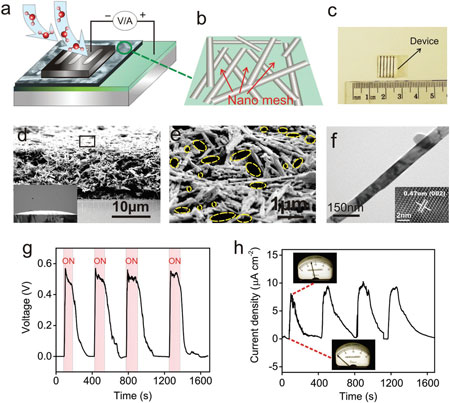| Posted: May 23, 2018 | |
Moisture-powered electronics |
|
| (Nanowerk Spotlight) In order to be fully autonomous, wearable electronics and stand-alone sensors and sensor networks require a built-in power generation capability that does not rely on external sources such as batteries or supercapacitors. A growing body of research is therefore exploring the fabrication of nano-sized power generators with triboelectric, thermoelectric or piezoelectric properties, allowing these devices to convert energy into electricity through mechanical stress, stretches and twists of fabrics (read more: "Wearable health monitoring with stretchable nanogenerators"). | |
| Very different from piezoelectric and other energy harvesting technologies, new research shows that water vapor or moisture expand the range of natural phenomena that can be used to generate electric power. | |
| "In our recent work we demonstrate that moisture, a vast kind of resource existing ubiquitously on earth and in biological organisms, can be exploited as a novel harvestable energy to generate electricity," Lei Liu, an associate professor in the Department of Mechanical Engineering at Tsinghua University in Beijing, tells Nanowerk. "Although some device configurations previously have been demonstrated to directly generate electricity from moisture, these generators have not been shown yet to be flexible and to be used as self-powered wearable devices." | |
| Liu and his collaborators, led by Profs. Zhou and Duley from the University of Waterloo, have published their findings in Advanced Materials ("Self-Powered Wearable Electronics Based on Moisture Enabled Electricity Generation"). | |
 |
|
| Device fabrication and characterization. a) Device schematic and configuration used for electrical measurements. b) A schematic representation of the resulting nanomesh structure in a TDNN. c) Photograph of an MEEG against a centimeter ruler. d) SEM image of the cross-section of a TDNN. Inset: wetting condition of TDNN. e) Magnified SEM image of the TDNN as marked in (d). Some pores are identified. f) Transmission electron microscopy (TEM) of a single nanowire. Inset: high-resolution TEM (HRTEM) image. g) Open-circuit voltage and h) short-circuit current density in response to an increase in RH to 85%. RH is increased during the times indicated by the shaded areas in g). The insets in (h) show the deflection of a micro ammeter connected across the output terminals of the MEEG during the RH cycles shown in (g). (Reprinted with permission from Wiley-VCH Verlag) (click on image to enlarge) | |
| The team's moisture energy harvesting device is based on strongly hydrophilic titanium dioxide (TiO2) nanowire networks (TDNNs) containing 3D nanochannels. Electricity is generated from the diffusion of water molecules (accreted from ambient moisture) through the many 3D nanochannels in the TDNN. | |
| The resulting moisture-enabled electricity generator (MEEG) can generate an open-circuit voltage of up to ∼0.5 V combined with a power density exceeding ∼4 µW cm-2 from a 1.2 x 1.2 cm device, (measured at a relative humidity of 85% ). This means that the moisture in human breath is capable of generating enough electricity to power a commercial light-emitting diode (LED). | |
| To demonstrate the practical application of this novel MEEG, the researchers fabricated self-powered wearable sensors based on this new concept. | |
| One example that the team demonstrated is a human breath sensor. "It is known that human-breathing characteristics such as breath frequency, depth, and intensity are symptomatic of physiological conditions such as anxiety, asphyxia, epilepsy, and incipient heart attack," explains Liu. "By harvesting water vapor from breath to power our device, it can at the same time be used to monitor breath characteristics; analysis of the resulting voltage pulses allows monitoring of human physiology via detection of breathing conditions." | |
| Another example the researchers demonstrated is based on the fact that water molecules continuously evaporate from the skin to the ambient environment. This process could inspire a moisture driven touch pad or artificial skins for robotics applications, which have a totally different operating mechanisms than existing touch pad technology. | |
| The team is now working on improving the electricity output of their devices by changing the design structure (e.g. by optimization of the top electrode geometry and by integration of MEEG cells into a 3D assembly) and material properties such as surface tension, zeta potential, or porosity. | |
| Another important goal they are pursuing is the exploration of new possibilities for practical applications in self-powered systems, such as photo-detection, chemical gas analysis, or environmental monitoring. | |
| However, a major challenge they need to overcome is that the current devices are easily influenced by ambient humidity level and temperature, which reduces the working stability if applied in some cases where the environmental conditions fluctuate a lot. | |
| "Our findings suggest that flexible nanowire networks are promising structures for harvesting energy from biological systems and facilitate the design of a wide range of self-powered flexible electronics and holds promise in the creation of a new range of innovative electronic devices," Liu concludes. | |
 By
Michael
Berger
– Michael is author of three books by the Royal Society of Chemistry:
Nano-Society: Pushing the Boundaries of Technology,
Nanotechnology: The Future is Tiny, and
Nanoengineering: The Skills and Tools Making Technology Invisible
Copyright ©
Nanowerk LLC
By
Michael
Berger
– Michael is author of three books by the Royal Society of Chemistry:
Nano-Society: Pushing the Boundaries of Technology,
Nanotechnology: The Future is Tiny, and
Nanoengineering: The Skills and Tools Making Technology Invisible
Copyright ©
Nanowerk LLC
|
|
|
Become a Spotlight guest author! Join our large and growing group of guest contributors. Have you just published a scientific paper or have other exciting developments to share with the nanotechnology community? Here is how to publish on nanowerk.com. |
|
